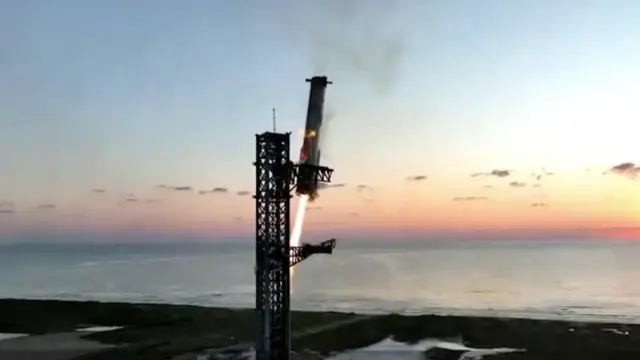SpaceX, the private space exploration company founded by Elon Musk, has successfully demonstrated an incredible feat of engineering during its most recent test flight.
On Sunday, the company managed to catch the Super Heavy booster stage of its massive Starship rocket using a giant robotic structure known as Mechazilla.

This landmark event represents a significant step toward building a fully reusable rocket system, rivalling or exceeding earlier space programs reliant on non-reusable rockets.
The innovative capture employed large mechanical arms, colloquially termed ‘chopsticks,’ that reached out to securely grasp the descending booster stage, a momentous accomplishment that has never been attempted, let alone achieved, before.
The enormous 397-foot-tall rocket lifted off from SpaceX’s Boca Chica launch facility on the Texas Gulf Coast at precisely 8:25 a.m.
Eastern Daylight Time. Powered by 33 Raptor engines, the rocket’s initial phase from the ground to booster separation provided a stunning spectacle as it lit up the morning sky with its fiery plume.
About three minutes and forty seconds post-launch, the Super Heavy booster completed its part of the journey.
While 13 of its Raptor engines reignited, the booster turned back toward the Texas coast after separating from the upper Starship stage, which continued its journey to space.
The booster returned for its exceptional capture by the Mechazilla’s chopstick arms, while the upper stage prepared for a splashdown in the Indian Ocean to simulate future space missions.
This was not merely a technical trial but a central episode in SpaceX’s path toward realizing Musk’s vision of ‘rapid reusability.’
Successful capture and recovery imply that SpaceX can potentially refurbish and relaunch its equipment swiftly, radically enhancing space travel’s economic efficiency.
Such a capture is essential not just for ease of reuse but for scaling up future exploratory missions.
The success offers a glimpse toward enabling heavy-lift launches that could facilitate crew-carrying spacecraft on potential lunar or Martian expeditions.
Prior to this, SpaceX demonstrated its capabilities with booster landings for the Falcon 9 series using autonomous methods.
Those techniques involved powered touchdowns on stationary landing pads or floating platforms at sea.
However, SpaceX’s new approach with Mechazilla sets higher aspiration by allowing quicker turnaround times for the world’s most formidable rocket.
The capture mechanism made its debut following extensive development and testing challenges, not to mention the cautionary tale from previous test flights where overheating caused considerable damage to the rocket’s components.
Thanks to corrective enhancements, Sunday’s launch has proven not only that the booster can be caught but also that it can be done with accuracy and reliability.
The Super Heavy’s formidable scale is no small part of the achievement.
The booster stands 230 feet tall and is capable of producing a thrust nearly twice that of NASA’s iconic Saturn V rocket used during the Apollo missions.
It operates with liquefied methane and oxygen, giving it both enormous power and efficiency.
Not everyone believed such an accomplishment was feasible. Jonathan McDowell, a well-known astronomer from Harvard, expressed his initial skepticism, tweeting his surprise at the maneuver’s success.
Indeed, SpaceX’s achievement illustrates not just technological prowess but a promising future for renewable space travel.
As ambitions in space exploration grow, so does the need for ingenuity in quickly refurbishing and relaunching spacecraft.
SpaceX, through its latest accomplishment, has potentially paved the way for a sustainable future in off-planet travel.
